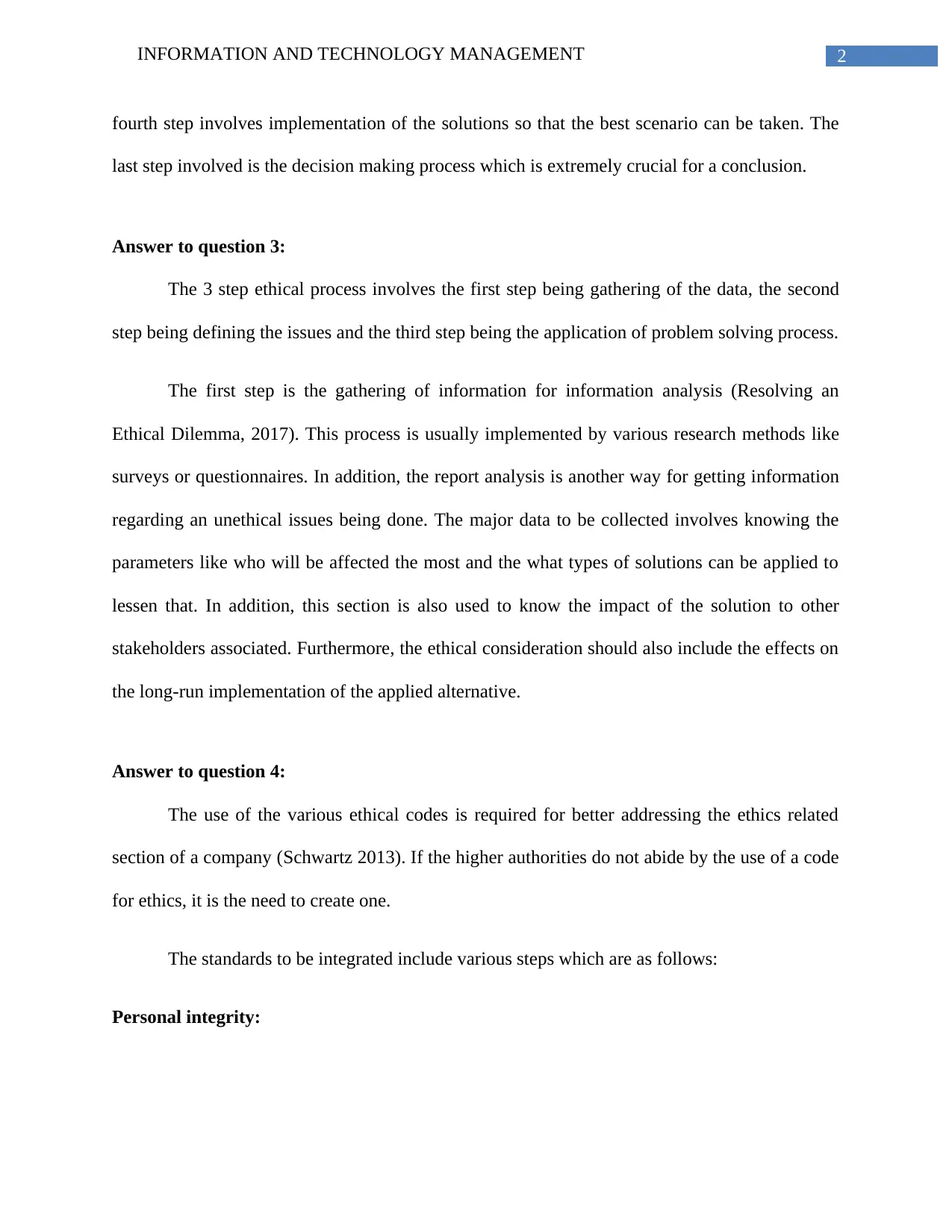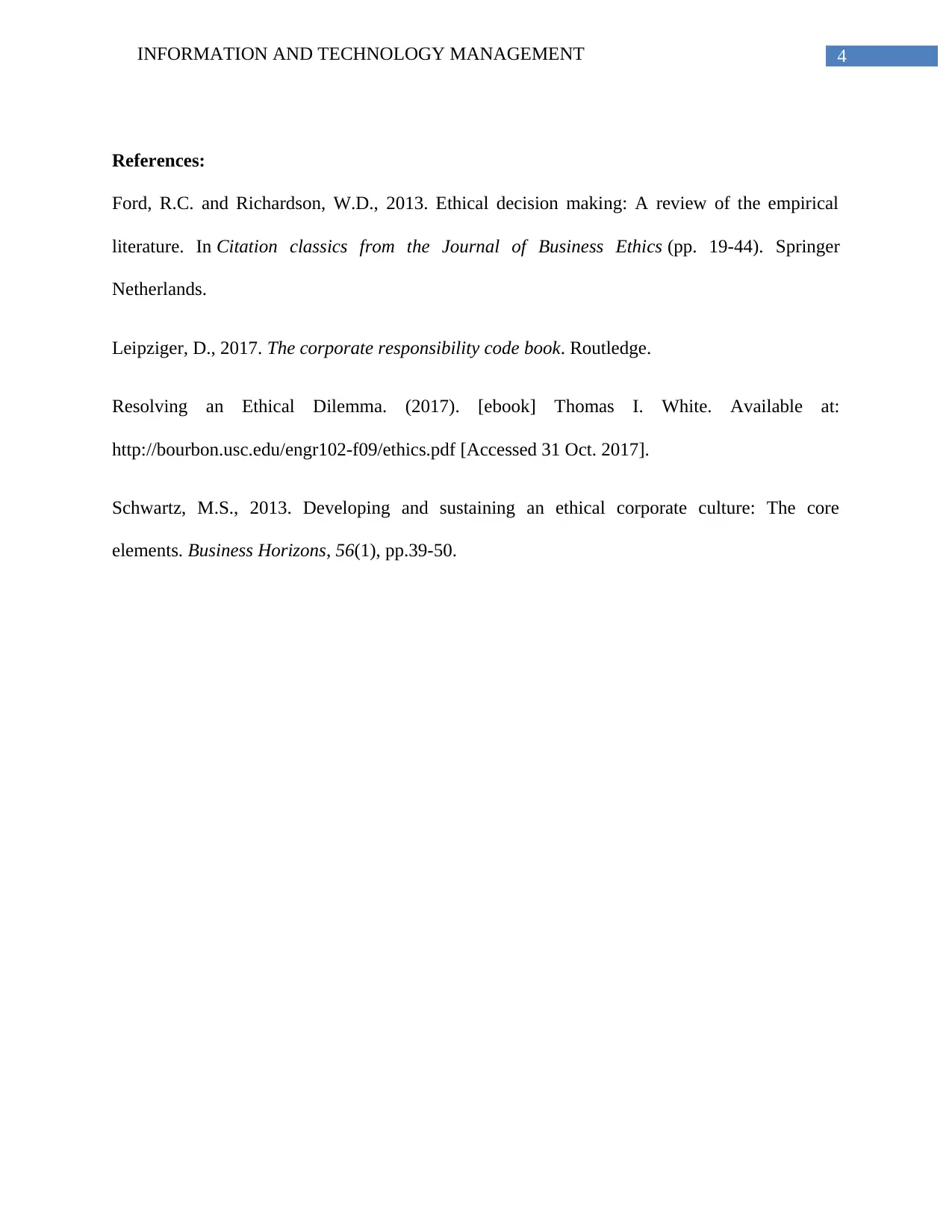University IT Management Assignment: Ethical and Practical Issues
VerifiedAdded on 2020/04/21
|5
|787
|64
Homework Assignment
AI Summary
This document presents a solution to an Information and Technology Management assignment. The solution addresses key aspects of IT management, including the ethical implications of company mergers, the application of the McDonald framework for resolving ethical dilemmas, and a 3-step ethical process. The assignment also explores the importance of ethical codes within a company and provides a framework for establishing such codes. The solution incorporates relevant references to support the arguments and findings. This assignment is designed to provide insights into real-world IT management challenges and ethical considerations. This document is available on Desklib, a platform offering AI-based study tools for students.

Running head: INFORMATION AND TECHNOLOGY MANAGEMENT
Information and communication technology management
Name of the student
Name of the University
Author Note
Information and communication technology management
Name of the student
Name of the University
Author Note
Paraphrase This Document
Need a fresh take? Get an instant paraphrase of this document with our AI Paraphraser

1INFORMATION AND TECHNOLOGY MANAGEMENT
Answer to question 1:
Company mergers are termed as unifying of the business prospects between two different
companies to create a single entity that will have the power to rule among all the employees
associated with the individual companies. This is mainly done for the sharing of resources and to
get more business revenue. They are also done sometimes when one company is unable to do
business while the other takes charge making it their own.
There are many cultural issues that may arise due to the merger between two
organizations (Ford and Richardson 2013). The first issue that will arise is the cross-cultural
issues of doing work that will affect the way of doing work. In addition, the major issues in the
aspect of ICT are the security and privacy. Due to the merger between two organizations, the
profiles of an employee can be directly accessible by the other organization. This in term
increases uneasiness in the employee.
Answer to question 2:
The case of conflict of interest, the accepted methodology is considered the McDonald
framework. The McDonald framework for ethical management is an efficient methodology for
solving ethics related problems. As Hardeep is involved with an ethical dilemma of whether
choosing his friend’s motives above the company, the need for this framework is required.
The first step in this framework involves the collection of information and identification
of the problem. This is used for analysis of the problem. The next step is the inclusion of
alternatives in the solutions. These are then used to address the business. The third step involves
identification of moral issues and other factors in cases of the alternatives (Leipziger 2017). The
Answer to question 1:
Company mergers are termed as unifying of the business prospects between two different
companies to create a single entity that will have the power to rule among all the employees
associated with the individual companies. This is mainly done for the sharing of resources and to
get more business revenue. They are also done sometimes when one company is unable to do
business while the other takes charge making it their own.
There are many cultural issues that may arise due to the merger between two
organizations (Ford and Richardson 2013). The first issue that will arise is the cross-cultural
issues of doing work that will affect the way of doing work. In addition, the major issues in the
aspect of ICT are the security and privacy. Due to the merger between two organizations, the
profiles of an employee can be directly accessible by the other organization. This in term
increases uneasiness in the employee.
Answer to question 2:
The case of conflict of interest, the accepted methodology is considered the McDonald
framework. The McDonald framework for ethical management is an efficient methodology for
solving ethics related problems. As Hardeep is involved with an ethical dilemma of whether
choosing his friend’s motives above the company, the need for this framework is required.
The first step in this framework involves the collection of information and identification
of the problem. This is used for analysis of the problem. The next step is the inclusion of
alternatives in the solutions. These are then used to address the business. The third step involves
identification of moral issues and other factors in cases of the alternatives (Leipziger 2017). The

2INFORMATION AND TECHNOLOGY MANAGEMENT
fourth step involves implementation of the solutions so that the best scenario can be taken. The
last step involved is the decision making process which is extremely crucial for a conclusion.
Answer to question 3:
The 3 step ethical process involves the first step being gathering of the data, the second
step being defining the issues and the third step being the application of problem solving process.
The first step is the gathering of information for information analysis (Resolving an
Ethical Dilemma, 2017). This process is usually implemented by various research methods like
surveys or questionnaires. In addition, the report analysis is another way for getting information
regarding an unethical issues being done. The major data to be collected involves knowing the
parameters like who will be affected the most and the what types of solutions can be applied to
lessen that. In addition, this section is also used to know the impact of the solution to other
stakeholders associated. Furthermore, the ethical consideration should also include the effects on
the long-run implementation of the applied alternative.
Answer to question 4:
The use of the various ethical codes is required for better addressing the ethics related
section of a company (Schwartz 2013). If the higher authorities do not abide by the use of a code
for ethics, it is the need to create one.
The standards to be integrated include various steps which are as follows:
Personal integrity:
fourth step involves implementation of the solutions so that the best scenario can be taken. The
last step involved is the decision making process which is extremely crucial for a conclusion.
Answer to question 3:
The 3 step ethical process involves the first step being gathering of the data, the second
step being defining the issues and the third step being the application of problem solving process.
The first step is the gathering of information for information analysis (Resolving an
Ethical Dilemma, 2017). This process is usually implemented by various research methods like
surveys or questionnaires. In addition, the report analysis is another way for getting information
regarding an unethical issues being done. The major data to be collected involves knowing the
parameters like who will be affected the most and the what types of solutions can be applied to
lessen that. In addition, this section is also used to know the impact of the solution to other
stakeholders associated. Furthermore, the ethical consideration should also include the effects on
the long-run implementation of the applied alternative.
Answer to question 4:
The use of the various ethical codes is required for better addressing the ethics related
section of a company (Schwartz 2013). If the higher authorities do not abide by the use of a code
for ethics, it is the need to create one.
The standards to be integrated include various steps which are as follows:
Personal integrity:
⊘ This is a preview!⊘
Do you want full access?
Subscribe today to unlock all pages.

Trusted by 1+ million students worldwide

3INFORMATION AND TECHNOLOGY MANAGEMENT
This section of the code is used for taking diligence and care in applying decisions so that
the undertaken decisions are meant to be honest and fair.
Relationship:
The company will treat people with courtesy and respect to comply with the business
standards.
Accountability:
The use of the company resources is to be used in an efficient and responsible way for
affecting the business in hand or other financial and natural resources.
This section of the code is used for taking diligence and care in applying decisions so that
the undertaken decisions are meant to be honest and fair.
Relationship:
The company will treat people with courtesy and respect to comply with the business
standards.
Accountability:
The use of the company resources is to be used in an efficient and responsible way for
affecting the business in hand or other financial and natural resources.
Paraphrase This Document
Need a fresh take? Get an instant paraphrase of this document with our AI Paraphraser

4INFORMATION AND TECHNOLOGY MANAGEMENT
References:
Ford, R.C. and Richardson, W.D., 2013. Ethical decision making: A review of the empirical
literature. In Citation classics from the Journal of Business Ethics (pp. 19-44). Springer
Netherlands.
Leipziger, D., 2017. The corporate responsibility code book. Routledge.
Resolving an Ethical Dilemma. (2017). [ebook] Thomas I. White. Available at:
http://bourbon.usc.edu/engr102-f09/ethics.pdf [Accessed 31 Oct. 2017].
Schwartz, M.S., 2013. Developing and sustaining an ethical corporate culture: The core
elements. Business Horizons, 56(1), pp.39-50.
References:
Ford, R.C. and Richardson, W.D., 2013. Ethical decision making: A review of the empirical
literature. In Citation classics from the Journal of Business Ethics (pp. 19-44). Springer
Netherlands.
Leipziger, D., 2017. The corporate responsibility code book. Routledge.
Resolving an Ethical Dilemma. (2017). [ebook] Thomas I. White. Available at:
http://bourbon.usc.edu/engr102-f09/ethics.pdf [Accessed 31 Oct. 2017].
Schwartz, M.S., 2013. Developing and sustaining an ethical corporate culture: The core
elements. Business Horizons, 56(1), pp.39-50.
1 out of 5
Related Documents
Your All-in-One AI-Powered Toolkit for Academic Success.
+13062052269
info@desklib.com
Available 24*7 on WhatsApp / Email
![[object Object]](/_next/static/media/star-bottom.7253800d.svg)
Unlock your academic potential
Copyright © 2020–2025 A2Z Services. All Rights Reserved. Developed and managed by ZUCOL.


